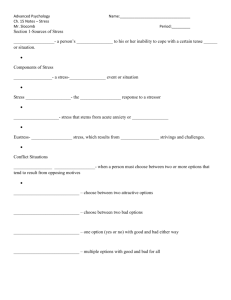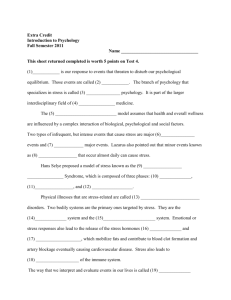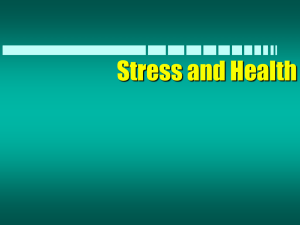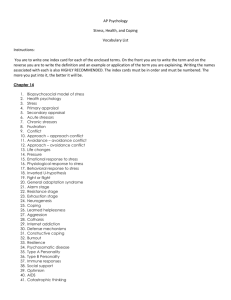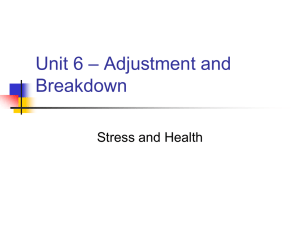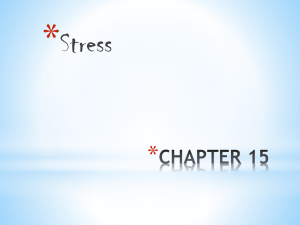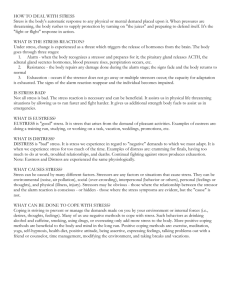ch. 15 ppt
advertisement
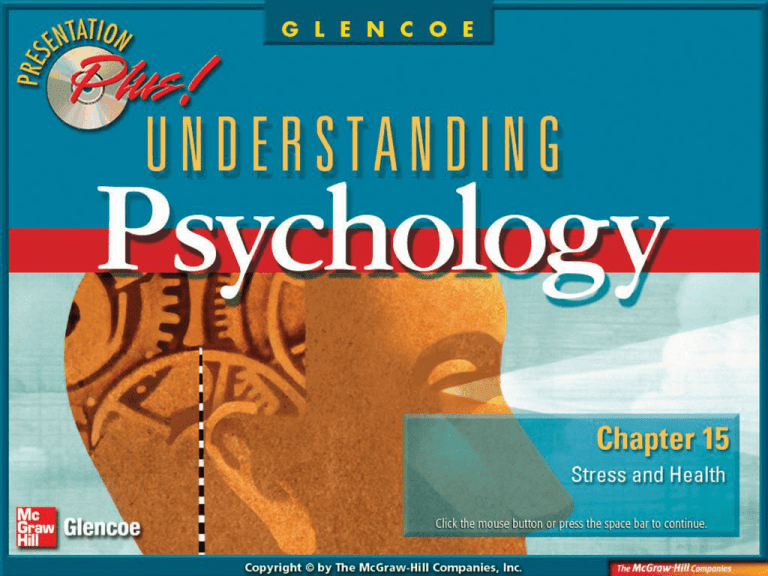
Chapter Introduction Section 1: Sources of Stress Section 2: Reactions to Stress Section 3: Coping with Stress Section 4: Stress in Your Life Chapter Objectives · Section 1 Sources of Stress Explain how stress results from our perceptions of demands placed upon us and our evaluations of situations we encounter. Chapter Objectives · Section 2 Reactions to Stress Describe the beneficial and harmful reactions people have to stress. Chapter Objectives · Section 3 Coping with Stress Explore the defensive and active coping strategies that people use to deal with stress. Chapter Objectives · Section 4 Stress in Your Life Describe how college and work can lead to stress. Main Idea Stress results from our perceptions of demands placed upon us and our evaluations of situations we encounter. Vocabulary • stress • stressor • stress reaction • distress • eustress • conflict situation Objectives • Define stress. • Identify various sources of stress. Do you find homework to be stressful? A. Yes B. No C. Sometimes 0% A A. A B. B C.0%C B 0% C Components of Stress • Stress • Stressor • Stress reaction Components of Stress (cont.) • Two types of stress: – Distress – Eustress Components of Stress (cont.) • Cognitive model of stress—how a person perceives and evaluates an event makes a difference. What is another name for positive stress? A. Stressor B. Stress reaction C. Distress D. Eustress 0% A A. B. C. 0% D. B A B C 0% D C 0% D Conflict Situations • Conflict situations Types of Conflict Situations Conflict Situations (cont.) • Four categories of conflict situations: – Approach-approach conflict—the individual must choose between two attractive alternatives. – Avoidance-avoidance conflict—when an individual confronts two unattractive alternatives. – Approach-avoidance conflict—when an individual wants to do something but has fears or doubts or is repulsed by it at the same time. – Double approach-avoidance conflict—the individual must choose between two or more alternatives, each of which has attractive and unattractive aspects. Conflict Situations (cont.) • How a person copes with stress depends on how he or she appraises the situation. • Primary appraisal refers to our immediate evaluation of the situation. Conflict Situations (cont.) • Three ways to appraise a situation: – Irrelevant – Positive – Negative Conflict Situations (cont.) • Secondary appraisal involves deciding how to deal with a potentially stressful situation. What do you call the conflict when you have to choose between two attractive alternatives? A. Approach-approach conflict B. Avoidance-Avoidance conflict 0% 0% 0% D A 0% A B C D C D. Double approach-avoidance conflict A. B. C. D. B C. Approach-Avoidance conflict Environmental Stressors • Noise is one of the foremost irritants in the lives of people. • Crowding can be another stressor. • The problem occurs not when you are crowded but when you feel crowded. • The effects of crowding depend on the situation. • Major life changes are a source of stress. Environmental Stressors (cont.) • Common to most of these events is the separation of an individual from familiar friends, relations, or colleagues. • Thomas H. Holmes and Richard H. Rahe developed the Social Readjustment Rating Scale (SRRS)—to measure the effects of 43 common events. The Social Readjustment Rating Scale Environmental Stressors (cont.) • Hassles are the relatively minor, day-today stressors. • Research has found a connection between hassles and health problems. • Small, positive events, called uplifts, can protect against stress and offset the effects of hassles. Some Daily Hassles Are holidays a stressful time for you? A. Yes B. No C. Sometimes 0% A A. A B. B C.0%C B 0% C Main Idea People react differently to life’s stressors. These reactions may be beneficial or harmful. Vocabulary • anxiety • anger • fear • immune system • social support Objectives • Give examples of the psychological, physical, and behavioral reactions to stress. • Identify stages of the stress reaction. Which of the following would cause the most stress for you? A. Upcoming tests B. Asking someone to go on a date C. Speaking in public D. Being sent to the principal’s office 0% A A. B. C. 0% D. B A B C 0% D C 0% D Fight-or-Flight Response • Regardless of the stressor, the body reacts with immediate arousal. Fight-or-Flight Response (cont.) • The adrenal glands are stimulated to produce: – hormones that increase the amount of blood sugar for extra energy. – adrenaline, which causes rapid heartbeat and breathing that enables the body to use energy more quickly. Fight-or-Flight Response (cont.) • Fight-or-flight response—this response prepares you to face potentially dangerous situations. The Fight-or-Flight Response Which body part produces adrenaline, which causes rapid heartbeat and breathing and enables the body use energy more quickly? A. Adrenal Glands B. Kidney C. Heart D. Pancreas 0% A A. B. C. 0% D. B A B C 0% D C 0% D General Adaptation Syndrome • Hans Selye identified three stages in the general adaptation syndrome: – Alarm – Resistance – Exhaustion According to Selye, which is NOT a stage in the body’s stress reaction? A. Alarm B. Resistance C. Exhaustion D. Acceptance 0% A A. B. C. 0% D. B A B C 0% D C 0% D Emotional and Cognitive Responses • The most common response to a sudden an powerful stressor is anxiety. Emotional and Cognitive Responses (cont.) • Other responses: – Anger may result from frustration. – Fear is the usual reaction when a stressor involves real or imagined danger. Emotional and Cognitive Responses (cont.) • Examples of short-term emotional stress: – Overreacting to minor irritations. – Getting no joy from daily pleasures. – Doubting one’s own abilities. Emotional and Cognitive Responses (cont.) • Cognitive reactions to stress: – Difficulty in concentrating or thinking clearly. – Recurring thoughts. – Poor decision making. Emotional and Cognitive Responses (cont.) • Continued frustration can lead to burnout. • Prolonged stress, such as burnout, in combination with other factors, adversely affects mental health. • Post-traumatic stress disorder—a condition in which a person who has experienced a traumatic event feels severe and long-lasting after-effects. Deepak Chopra What is the most common response to a sudden and powerful stressor? A. Anxiety B. Anger C. Fear D. Acceptance 0% A A. B. C. 0% D. B A B C 0% D C 0% D Behavioral Reactions • People react to stress in very different ways. • Stress can cause positive or negative short-term behavioral changes. • Escape is another behavioral stress reaction. Which is a behavioral reaction to stress? A. Aggression B. Escape 0% D A 0% A B C 0% D C D. All of the above A. B. C. 0% D. B C. Develop a nervous habit Physical Reactions • Some people develop psychosomatic symptoms as a result of stress. • The physiological fight-or-flight response is the body’s first reaction to stress. Physical Reactions (cont.) • Stress is also a contributing cause of illness. • It can directly cause an illness, or it can weaken your immune system, allowing infection to invade your body. What kind of illness can emotional stress cause? A. Peptic ulcers B. Hypertension C. Asthma D. All of the above 0% A A. B. C. 0% D. B A B C 0% D C 0% D Factors Influencing Reactions to Stress • Personality differences effect stress. • Type A personalities are very likely to have coronary artery disease, often followed by heart attacks, in their 30s and 40s. • Emotional expressiveness can also effect a person’s reaction to stress. Factors Influencing Reactions to Stress (cont.) • Physical disorders are more likely to happen when we do not have control over stressors. • Feedback is an important factor. Factors Influencing Reactions to Stress (cont.) • Social support can buffer an individual from the effects of stress. Factors Influencing Reactions to Stress (cont.) • Social groups offer at least four kinds of support: – Emotional – Appraisal – Informational – Instrumental Which type of support represents active, positive support in the form of direct help such a place to live? A. Emotional B. Appraisal 0% D A 0% A B C 0% D C D. Instrumental B C. Informational A. B. C. 0% D. Main Idea People deal with stress by employing defensive and active coping strategies. Vocabulary • cognitive appraisal • denial • intellectualization • progressive relaxation • meditation • biofeedback Objectives • Explain defensive strategies of coping with stress. • Describe active strategies of coping with stress. How well do you deal with stress? A. I ignore it B. I try to rid the stress C. I talk to someone D. I try to avoid stress 0% A A. B. C. 0% D. B A B C 0% D C 0% D Psychological Coping Strategies • Coping with stress is an attempt to gain control over a part of one’s life. • Cognitive appraisal Psychological Coping Strategies (cont.) • Defensive coping strategies: – Denial – Intellectualization – Active coping strategies involve changing our environment or modifying a situation to remove stressors or reduce the level of stress. Types of Coping Strategies Psychological Coping Strategies (cont.) • Active coping strategies include: – Hardiness – Controlling stressful situations – Problem solving – Explanatory style—pessimist versus optimist Irrational Assumptions That Can Cause Stress Psychological Coping Strategies (cont.) – Relaxation • Progressive relaxation • Meditation – Biofeedback – Humor – Exercise Psychological Coping Strategies (cont.) – Support groups and professional help – Training – Improving interpersonal skills Stress: A Summary Model Which active coping strategy do you think is the most effective? A. Hardiness B. Controlling stressful situations 0% D A 0% C D. Explanatory style B C. Problem solving A. A B. B C. 0%C 0% D. D Main Idea For many people, college and work involve adjustment and stress. Vocabulary • autonomy • developmental friendship • resynthesis • career • comparable worth Objectives • Identify some of the issues related to adjustment to college life. • Describe issues related to starting a first job. When do you think you are independent from your parents? A. During high school years B. When you move out of the house C. When you get a job D. Never completely independent 0% A A. B. 0% C. D. B A B 0% C D C 0% D Stress in Your Life • Autonomy • The emotional upheaval many first-year college students feel has been called “college shock.” Choosing College • Ways going to college stimulates change: – College may challenge the identity a student has established in high school. – Students encounter greater diversity than they ever have before. • Developmental friendships – Instructors and assigned books may shape a student as well. Choosing College (cont.) • Ways of coping with change: – Some students focus more narrowly when their goals are threatened by internal or external change. – Others avoid confront doubt by frittering away their time, going through the motions of attending college but detaching themselves emotionally. – Some manage to keep their options open until they have enough information and experience to make a choice. Choosing College (cont.) • Resynthesis According to Madison, which is NOT a method of coping with stress in college? A. Resynthesis B. Focus more narrowly C. Change majors D. All of the above 0% A A. B. 0% C. D. B A B 0% C D C 0% D Working • Each person’s work experience is different and each person reacts differently to a job as a result of his or her own personality. Working (cont.) • Five major sources of work satisfaction: – Resources – Financial reward – Challenges – Relations with coworkers – Comfort Working (cont.) • Some theorists predict that people will change their career several times in their lifetime. • Comparable worth – The market value of many jobs traditionally held by women is considerably lower than that of comparable jobs traditionally held by men. – Men and women are not evenly distributed among the various occupations. Working (cont.) • Two laws that were created to address inequalities: – The Equal Pay Act of 1963 – The Civil Rights Act of 1964 Distribution of Male and Female Workers by Occupation Which would give you the most work satisfaction? A. Financial reward B. Comfort C. Challenge D. Relations with coworkers 0% A A. B. 0% C. D. B A B 0% C D C 0% D Types of Conflict Situations Conflict situations cause stress because you must give up something you want to get or face something you wish to avoid. The Social Readjustment Rating Scale The SRRS lists 43 items that require individuals to make the most changes in their lives. Each number (mean value) refers to the expected impact that event would have on one’s life. To obtain your score, add the numbers associated with each event you experienced in the past year. The total number reflects how much life change you have experienced. Some Daily Hassles We face frustration every day—these are the daily hassles of life. The Fight-orFlight Response Our fight-or-flight response is triggered by potentially dangerous or stressful situations, such as a scare in the middle of the night or giving a speech in public. As soon as you feel threatened, your body prepares itself for action. Types of Coping Strategies The two major ways that people deal with stress are by either focusing on it and trying to reduce it or ignoring the stress completely. Irrational Assumptions That Can Cause Stress Some people hold selfdefeating, irrational beliefs that cause stress and prevent them from adequately adjusting to life’s challenges. Stress: A Summary Model Your evaluation of a situation interacts with the stressor and what you perceive to be the available resources to determine how you react to the stressor. You respond to stress on several levels. Distribution of Male and Female Workers by Occupation One of the reasons for differences in pay between the genders is that men and women are not evenly distributed among occupations. If men tend to cluster in higher-paid occupations and if women tend to cluster in lower-paid occupations the average pay of men and women will differ. Deepak Chopra 1947– “By quieting the mind which then quiets the body and the less turbulent the body is, the more the selfrepair, healing mechanisms get amplified.” Chapter Concepts Transparencies Four Types of Conflict Common Reactions to Stressors Select a transparency to view. stress: a person’s reaction to his or her inability to cope with a certain tense event or situation stressor: a stress-producing event or situation stress reaction: the body’s response to a stressor distress: stress that stems from acute anxiety or pressure eustress: positive stress, which results from motivating strivings and challenges conflict situation: when a person must choose between two or more options that tend to result from opposing motives anxiety: a vague, generalized apprehension or feeling of danger anger: the irate reaction likely to result from frustration fear: the usual reaction when a stressor involves real or imagined danger immune system: the body’s natural defense system against infection social support: information that leads someone to believe that he or she is cared for, loved, respected, and part of a network of communication and mutual obligation cognitive appraisal: the interpretation of an event that helps determine its stress impact denial: a coping mechanism in which a person decides that the event is not really a stressor intellectualization: a coping mechanism in which the person analyzes a situation from an emotionally detached viewpoint progressive relaxation: lying down comfortably and tensing and releasing the tension in each major muscle group in turn meditation: a focusing of attention with the goal of clearing one’s mind and producing an “inner peace” biofeedback: the process of learning to control bodily states by monitoring the states to be controlled autonomy: ability to take care of oneself and make one’s own decisions developmental friendship: friends force one another to reexamine their basic assumptions and perhaps adopt new ideas and beliefs resynthesis: combining old ideas with new ones and reorganizing feelings in order to renew one’s identity career: a vocation in which a person works at least a few years comparable worth: the concept that women and men should receive equal pay for jobs calling for comparable skill and responsibility To use this Presentation Plus! product: Click the Forward button to go to the next slide. Click the Previous button to return to the previous slide. Click the Home button to return to the Chapter Menu. Click the Transparency button from the Chapter Menu or Chapter Introduction slides to access the Concept Transparencies that are relevant to this chapter. From within a section, click on this button to access the relevant Daily Focus Skills Transparency. Click the Return button in a feature to return to the main presentation. Click the Psychology Online button to access online textbook features. Click the Exit button or press the Escape key [Esc] to end the chapter slide show. Click the Help button to access this screen. Links to Presentation Plus! features such as Profiles in Psychology and relevant figures from your textbook are located at the bottom of relevant screens. This slide is intentionally blank.
